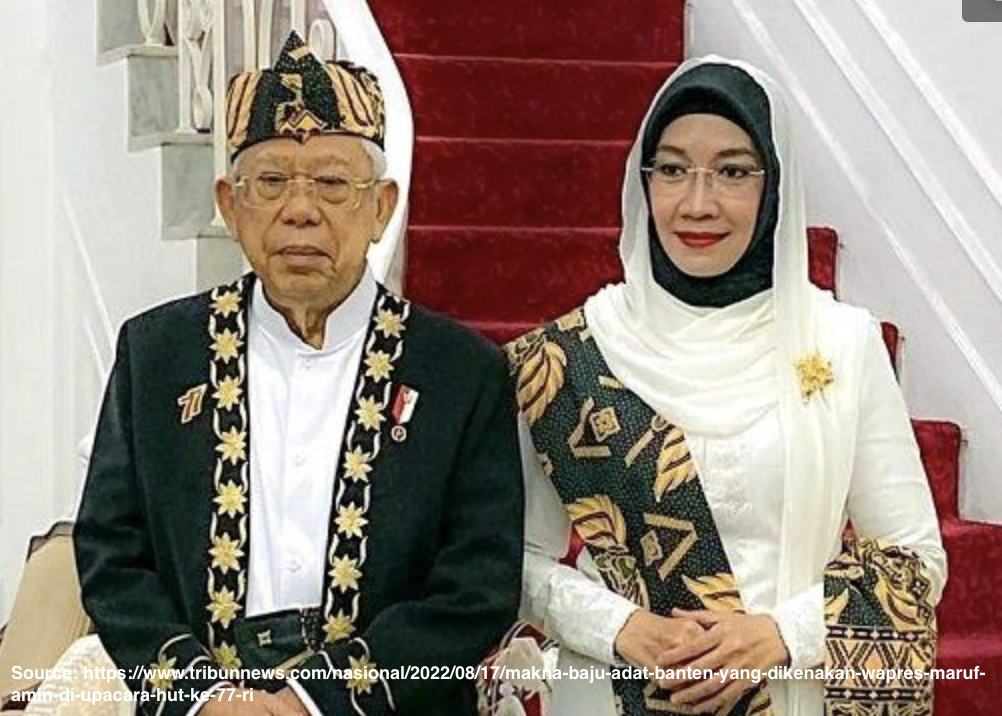Abstract
Banten is the westernmost region of Java island that is famous for its religiosity and distinctive culture. This study aimed to describe the characteristics of the groom’s makeup for Kebesaran Banten (The Name of the Groom’s makeup) and reveal the value of Islamic education for the bride and groom. This qualitative study used Spradley’s ethnographic research approach. Data were collected using in-depth interviews, participant observation, and documentation. The results revealed that the groom of Kebesaran Banten had natural soft makeup encrusted with golden makutaraja (crown) and a necklace of jasmine on the chest. The clothes were made of red, green, or black velvet, decorated with the side cloth of the Banten Sultanate and a shoulder sash. The groom wore trousers and sandals of the same color. At the waist, a dagger and a short spear were tucked in with a jasmine flower garland. This make-up represented Islamic culture that combined Javanese Hindu, Chinese, and European cultures. The value of Islamic education was manifested in the values of faith, morals, physical, rationality, psychological, sexual, and social. This makeup could be developed as a medium for internalizing the value of Islamic education for brides in forming a happy family based on faith. Overall, this make-up depicts the husband's figure as a family leader who is faithful, visionary, hardworking, maintaining family honor, and full of love.
References
Aytuğ, S. M. (2015). Make Up As a Sign of Public Status. Procedia - Social and Behavioral Sciences, 195, 554–563. https://doi.org/10.1016/j.sbspro.2015.06.272
Minnuril Jannah, R. N., & Halim, A. (2022). Edukasi Pra Nikah Sebagai Upaya Pencegahan Perceraian Perspektif Hukum Islam Dan Hukum Positif. Amalee: Indonesian Journal of Community Research and Engagement, 3(1), 167–178. https://doi.org/10.37680/amalee.v3i1.1308
Santoso, T. (2010). Tata Rias dan Busana Pengantin Seluruh Indonesia. Kompas Gramedia. https://books.google.co.id/books?hl=en&lr=&id=PDRhDwAAQBAJ&oi=fnd&pg=PP1&dq=buku+pengantin+tradisional&ots=5Tx7wC5NUy&sig=jzMV4jlFk1Pi7FQ9DwyTdJ8izjA&redir_esc=y#v=onepage&q&f=false
Ary, D. et. al. 2010. Introduction to Research in Education 8th edition. Wadsworth Cengage Learning. Canada: Nelson Education Ltd.
Adeng. 2010. Pelabuhan Banten Sebagai Bandar Jalur Sutra. Patanjala Vol. 2, No. 1, Maret 2010: 80-94.
Aziz, S. (2017). Tradisi Pernikahan Adat Jawa Keraton Membentuk Keluarga Sakinah. IBDA`: Jurnal Kajian Islam Dan Budaya, 15(1), 22-41. https://doi.org/https://doi.org/10.24090/ibda.v15i1.724
Bruinessen, Martin van. 1995. Kitab Kuning, Pesantren dan Tarekat: TradisiTradisi Islam di Indonesia. Bandung: Mizan.
Creswell, J. W. (2012). Educational research: Planning, conducting, and evaluating Quantitative and qualitative research (4th ed). Boston, MA: Pearson.
Melati Banten Province. 2013. Tata Rias Pengantin Kebesaran Banten. Banten: Subkonsorium Tata Rias Pengantin Daerah Provinsi Banten.
Defa, M. T. (2018). Perpaduan Gaya Arsitektur Jawa Kuno, Tiongkok, dan Eropa pada Arsitektur Masjid Agung Banten. Seminar Ikatan Peneliti Lingkungan Binaan Indonesia (IPLBI) 1, A 051-054 https://doi.org/10.32315/sem.1.a051.
Guillot, C. (1990). The Sultanate of Banten. Gramedia Book Publishing Division. 19.
Haryati, YS et.al. (2018). Komparasi Minat Perias Pengantin Terhadap Kain Kasultanan Banten Dan Lereng Barong Dalam Tata Rias Pengantin Kebesaran Banten. Untirta Civic Education Journal (UCEJ). Home > Vol 3, No 1 (2018). DOI: http://dx.doi.org/10.30870/ucej.v3i1.3611.
Hamid, A. (2010). Memetakan Aktor Politik Lokal Banten Pasca Orde Baru: Studi Kasus Kiai dan Jawara di Banten. Politika, Jurnal Ilmu Politik, 2010.
Humaeni, A. (2015). Ritual, Kepercayaan Lokal Dan Identitas Budaya Masyarakat Ciomas Banten. El Harakah Vol.17 No.2 Tahun 2015.
Iskandar, Yoseph. 2011. Sejarah Banten. Tryana Sjam’un Corp. Rangkas Bitung.
Indriastuty, HR. et. al. (2020). Bangunan Masjid Agung Banten sebagai Studi Sosial dan Budaya. Pattingalloang, Jurnal Pemikiran Pendidikan dan Penelitian Kesejarahan Vol. 7, No.2 Agustus 2020, 119-132 |121.
Ministry of National Education. (2009). Tata Rias Pengantin Dengan Paes. Jakarta: Kemendiknas.
Minnuril Jannah, R., & Halim, A. (2022). Edukasi Pra Nikah Sebagai Upaya Pencegahan Perceraian Perspektif Hukum Islam Dan Hukum Positif. Amalee: Indonesian Journal of Community Research and Engagement, 3(1), 167-178. https://doi.org/10.37680/amalee.v3i1.1308
Ministry of Religion. (1999). “Mengenal Peninggalan Sejarah dan Purbakala Kota Banten Lama.” Pp. 72-234, dalam Banten Menuju Masa Depan. Cilegon: Yayasan Kiai Haji Wasid.
Ministry of Education and Culture. (2021). Mahkota: Cagar Budaya Banten. http://cagarbudaya.kemdikbud.go.id/cagarbudaya/detail/PO2017080100012/mahkota-sultan-banten-koleksi-museum-nasional-no-)-.
Ministry of Education and Culture. (2021). Keraton Kaibon Banten. http://cagarbudaya.kemdikbud.go.id/cagarbudaya/detail/PO2016061000055/keraton-kaibon
Marwoto, I. (2019). Modal Dan Kuasa Banten Abad XVI-XVII. Jakarta: Universitas Indonesia Library
Mujib, A. & Mudzakir, J. (2006). Ilmu Pendidikan Islam. Jakarta: Kencana Prenada Media, 2006.
Mulyono, K. (2010). Seni Rias Modifikasi Daerah Indonesia. Jakarta. Katalia.
Nugroho, B & Mustaidah. (2017). Identifikasi Nilai-Nilai Pendidikan Islam Dalam Pemberdayaan Masyarakat Pada PNPM Mandiri. Jurnal Penelitian,Vol. 11, No. 1, Februari 2017.
Pranowo, M. B. (2020). Pengantar Studi Kebudayaan, Memahami Islam Jawa. Progress : Jurnal Pendidikan Agama Islam Universitas Wahid Hasyim Semarang. Volume 8, No. 1, Juni 2020.
Banten Provincial Government. (2021). Profil Banten. https://bantenprov.go.id/
Santoso, T. (2010). Tata Rias Dan Busana Pengantin Seluruh Indonesia. Jakarta: Gramedia Pustaka Utama.
Said, H. A. (2016). Islam dan Budaya Di Banten: Menelisik Tradisi Debus Dan Maulid. Kalam, Vol 10, No 1 (2016). https://doi.org/10.24042/klm.v10i1.338.
Saryoto, N. 2012. Tata Rias Pengantin dan Adat Istiadat Pernikahan Surakarta Klasik Solo Puteri. PT Gramedia Pustaka Utama. Jakarta.
Sumiani, S. (2019). Simbol dan Makna Tata Rias Pengantin Bugis Makassar. Jurnal Pakarena, 1(1), 1-17. doi: https://doi.org/10.26858/p.v1i1.8079
Tjandrasasmita, U. (2011). Banten Abad XV-XXI. Pencapaian Gemilang, Penorehan Menjelang. Jakarta: Puslitbang Lektur dan Khazanah Keagamaan.
Usman, J. (2018). Kaidah-Kaidah Dasar Pendidikan Anak (Studi Komparasi Pemikiran Abdullah Nasih Ulwan dengan Maria Montessori). TADRIS: Jurnal Pendidikan Islam, 13(1), 149 - 167. https://doi.org/10.19105/tjpi.v13i1.2052
Faidah, M. Islamic Values in Banjar Bridal Makeup: Developing Local Wisdom as Character Education. Humanus. Vol 20. No 1 (2021). DOI: https://doi.org/10.24036/humanus.v20i1.111417
Windiani & Farida Nurul R. 2016. Menggunakan Metode Etnografi Dalam Penelitian Sosial. Dimensi, 2016, Vol 9(2): 87-92.
Wijaya, H. (2018). Analisis Data Kualitatif Model Spradley (Etnografi). https://www.researchgate.net/publication/323557072_Analisis_Data_Kualitatif_Model_Spradley_Etnografi/citation/download.
Zahra, A & Achmad H. (2013). Pengembangan Ragam Hias Batik Banten dengan Teknik Reka Latar. Craft, vol. 2, no. 1, 2013.

This work is licensed under a Creative Commons Attribution-NonCommercial 4.0 International License.
Copyright (c) 2022 ETNOSIA : Jurnal Etnografi Indonesia





